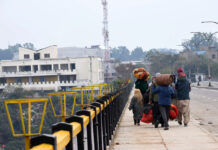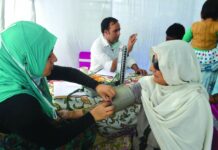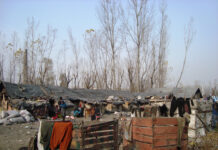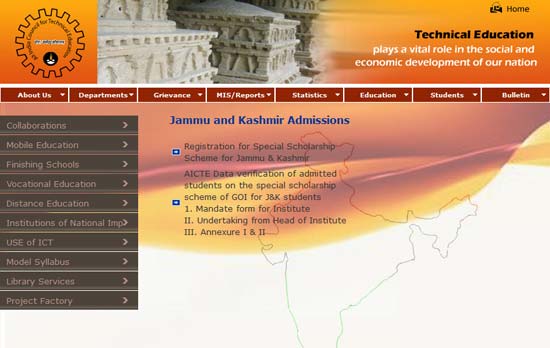In Kashmir where children are counted as adults at 16 years, juvenile justice is a far cry. Majid Maqbool meets up with young detainees, the alleged stone throwers, to understand how justice is dispensed by a stunted system.
Surrounded by policemen, Feroz Ahmad Khan, 14, and Samir Farooq, 15, are allowed to sit for a while in the open sun in the lawn of the only juvenile detention centre in Kashmir on the outskirts of Srinagar at Harwan. After sometime, they are taken back to the confines of their dormitory. The boys quietly stand near a window and look at the traffic plying outside. Everyday they wait for their parents to come with the news of their release. But as yet another day of detention ends, their hopes of freedom fade into the dejection of imprisonment.
 These young ones had been arrested by Nowhatta police a week earlier on charges of stone pelting. The Next day, the police produced them, handcuffed, before a court in Srinagar. The judge, finding them minors, directed the authorities to detain them in the newly constructed juvenile jail in Harwan. Two other boys, who were brought to the juvenile jail with Feroz, were bailed out. Feroz and Samir are the only two boys detained in the juvenile jail now. They don’t talk much. Although the juvenile detention centre has better facilities than a police lockup, where minors are often locked up with adults, it’s still a jail for them nevertheless.
These young ones had been arrested by Nowhatta police a week earlier on charges of stone pelting. The Next day, the police produced them, handcuffed, before a court in Srinagar. The judge, finding them minors, directed the authorities to detain them in the newly constructed juvenile jail in Harwan. Two other boys, who were brought to the juvenile jail with Feroz, were bailed out. Feroz and Samir are the only two boys detained in the juvenile jail now. They don’t talk much. Although the juvenile detention centre has better facilities than a police lockup, where minors are often locked up with adults, it’s still a jail for them nevertheless.
“I was going to my home when I was arrested by the police near the Nowhatta police station on a Friday afternoon,” said Feroz Ahmad, a 6th standard school dropout.
Along with Feroz, nine other boys were locked up in the police station that night. They were not allowed to meet their parents. “I was beaten up near the police station and locked up for a night,” he said. “Inside the police gypsy they kicked us and abused our mothers and sisters. Even the CRPF troopers standing near the police station joined the policemen and started kicking us.”
Feroz said that Friday there was no stone pelting in Nowhatta, yet the police beat them up and arrested them on charges of stone pelting. He remembers one boy, who was detained with him in the juvenile jail and later bailed out, had a big wound on his head. “He told me that he had gone out to buy some goods when he was arrested, and then he was hit on his head by the policemen with their rifle butts,” Feroz recalled the boy telling him.
At 14 years, Feroz is trying to understand the complexities of his case, and the meaning of “bail”. “I just need two signatures of the judge in my case,” he said confidently, “and if he signs them quickly, I will get out of here on bail.”
When Samir was arrested near the Nowhatta police station, he was returning home after buying some vegetables. “I don’t know how they can arrest us on charges of stone pelting when there was no stone pelting in that area that day,” said Samir who, after dropping out of school, worked in a shop as a sales boy. He said they were beaten up inside the police station. And even the next day when we were produced before the court, Samir said, the policemen accompanying them kicked the handcuffed boys from behind.
“They have filed many cases against us for stone pelting that happened in summer this year,” said Samir, worried that the police will be after him even after his release from the juvenile centre. He says the police often fail to get hold of the real stone pelters in their area as they often give them a slip. “Then the policemen come after us as they have to show results to their officers,’ he said. “We are then passed off as stone pelters.”
There were three more boys (all under 17 years of age), who were brought to this juvenile home few months back. They were earlier imprisoned in Srinagar central jail for more than two years. Their parents had moved an application to transfer their children to the juvenile jail after they came to know about its existence. After over two months the boys were recently bailed out.
“Till this month 30 boys, all under-18 years of age, were brought here. And out of them, 28 boys have been bailed out till now,” said Ghulam Ahmad, the superintendent of the juvenile jail that started functioning in August this year. He says the juvenile centre can accommodate a maximum of 50 minors at present, but it is still without a child counseling facility.
The three-storey jail was first proposed as an orphanage by the government. It has 17 dormitories, an entertainment hall, and a badminton court, besides other facilities for the young detainees. This facility also makes arrangements for children who have to appear in board examination while in detention. The juveniles, accompanied by a police party, are then brought to the examination centre. Besides the superintendent, it has a regular staff that comprises of four policemen, one junior assistant, one caretaker, one cook, one attendant and an orderly.
The superintendent says most of the kids brought to the juvenile centre these days come from downtown area in Srinagar. Almost all of them are involved in stone pelting, he claims, adding that “most of the kids are from poor economic background.” Had juvenile detention centers been set up in earlier years in the valley, he says, things would have been different and kids would not get mixed up with criminals in the police lockups.
Legal experts say the existing Juvenile Justice Act 1997 is obsolete. It was based on the Child Rights Act enacted by the Indian Parliament in 1997, which was later amended into Juvenile Justice Act 2007.Under this law the age limit for a minor has been extended up to 18 years.
In Jammu and Kashmir, however, 16 years is the cut off for being considered a juvenile. Under the central Juvenile Justice Act, child welfare committees are set up and every police station is supposed to have a special police officer dealing with juvenile cases.
“Even the old 1997 juvenile justice act is not implemented here in spirit,” said Faisal Qadri, a High Court lawyer. The 1997 Act requires special juvenile courts to be set up, apart from establishing juvenile homes. Qadri says, besides care and protection, the juvenile act requires juvenile homes to be set up in every district. “One juvenile centre recently set up in the valley in inadequate to deal with increasing number of juvenile arrests by the police in recent years.”
“For example, if some kid from Baramulla is arrested for stone pelting by the police, it will be difficult to bring him to a juvenile centre in Srinagar,” says Qadri. “Those kids are often locked up in police stations in their districts.”
According to Qadri, it is illegal to imprison minors in police lockups, which has become a norm in Kashmir. “Even if they are accused of serious crime, you can’t keep minors in police lockups.”
In the wake of criticism by global human rights bodies including Amnesty International (AI), the state government frameda new law to replace the “flawed” and “obsolete” JK Juvenile Justice Act -1997. The new law addresses the concerns raised by the rights bodies about the lacuna found in the 1997 Act. It also tackles the issue of minors arrested under Public Safety Act, which created furore last year. The new law calls for raising the maximum age limit of minors from 16 to 18.
 In June, on directions from chief minister, Omar Abdullah, Social Welfare Departmentsent draft rules ofa new law to the Law Department for clearance. But after the Law Department cleared it in September, the new law has been reportedly caught in a to-and-fro between the Social Welfare Department and the Finance Department over financial requirements for its implementation.
In June, on directions from chief minister, Omar Abdullah, Social Welfare Departmentsent draft rules ofa new law to the Law Department for clearance. But after the Law Department cleared it in September, the new law has been reportedly caught in a to-and-fro between the Social Welfare Department and the Finance Department over financial requirements for its implementation.
The implementation of the newlegislation of 2007 is estimated to cost around Rs 200 crore, money required for setting up of Juvenile Homes in all districts.
However, legal experts say additional funds required for setting up of juvenile homes in districts is no excuse. “If there’s a law in existence, the government can’t come up with the excuse of limited funds,” saidQadri. “Either they have to follow the law till the time it is in existence and set up juvenile homes in every district, or they should repeal the law if they can’t follow it.”
Former District and Sessions Judge BL Saraf says in the central Act the problem faced by the children has been clearly demarcated. A child who may have committed a crime is no longer treated as a criminal in the central Act, he points out, but as one who has unwittingly come in ‘conflict with law’.
“The State Juvenile Justice law is not as elaborate as the central one, and whatever has been provided in the law for the trial of juvenile offenders or for care of the neglected children doesn’t stand on the ground,” saidSaraf. “For instance, under the Act, Juvenile Justice Board is to conduct trial of a juvenile offender, but as of now no such boards exist on the ground here. Nobody has heard of shelter homes or child welfare committees to look after a child who is in need of care and protection.”













